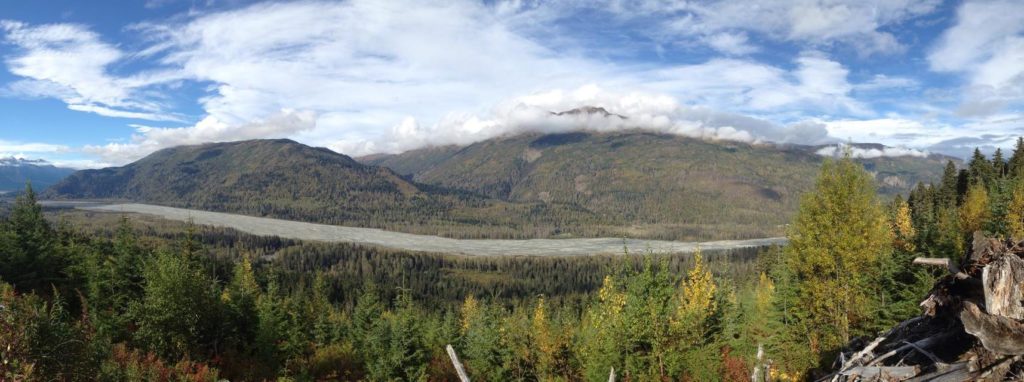It’s Spring in the Upper Lynn Canal! But before anyone starts their gardens, it may be wise to think about food storage. Haines grower Rebecca Brewer showed KHNS her root cellar to explain how good long-term storage can improve food security.
It’s been about a decade since Rebecca Brewer started her garden in Haines. She works to produce year round food for two people and a small summer fresh produce business. In the winter she sells potatoes and carrots.
Brewer’s had a root cellar since 2012, when pressure from heavy snowfall broke out a window in the back room of her cabin. She flips on a light and leads me through into a chilly room at the back of her house.
“At first I was really sad about the window being smashed, and then I thought, “Wait a minute! This room was really meant for vegetables,” she said.
She turned the accident into a storage system that keeps her crops ready to eat throughout the year. She used the open window to create a vent system that keeps the room cool in the summer and just above freezing in the winter.
“I store potatoes in here; this is all potatoes in crates. I store beets and carrots in totes of damp sawdust. Any root crop stores well in this medium which is damp sawdust,” she explained as she opened up a big plastic storage crate full of vegetables.
Garlic and onions hang on the walls and squash is up on a high shelf where it’s a little warmer and drier. The potato crates are on the ground. Canned salmon and meat is on the shelves in between. Brewer just finished eating the cabbages that used to hang from their roots on another wall.
“So, that’s pretty good timing because I’m about to start kale plants. I like to make that loop happen where I’m always eating something of my own,” she said.
That idea, that one should always eat something homegrown, is essential to Brewer, but not something most post-industrial households even try to achieve. Local grocery stores stock all the food most families need, regardless of the season. And because of low oil prices its less expensive to import food than grow it here in Alaska.
According to public health Professor Elizabeth Hodges Snyder at University of Alaska Anchorage, that means most food comes to Alaska through a long supply chain. Alaska imports approximately 95% of its food.
“It’s not an unusual number in any sense,” she said. “There’s similar numbers for other states as well. The difference for Alaska is we don’t necessarily have a similar number for export, so if we were to have a significant interruption in our imports we don’t have the same amount of food to sit on and to feed our local populations. And that is the concern.”
If anything happened that shut down food shipments, Dr. Hodges Snyder says it wouldn’t take long for grocery stores to sell out of their stocks. Depending on where you are and whom you ask, most areas would run out of food in three to ten days.
She says solutions like root cellars are part of building more resilient local food systems.
“Those are an important part of a patchwork quilt of preparedness. One of our shortcomings in our current food structure here in the state is not having well established and well distributed places for food storage and holding food prior to distribution. The more individuals and local communities that can safely store food the better,” said Snyder.
Dr. Hodges Snyder says that’s especially important in Alaska and the circumpolar north because of long winters where people aren’t actively harvesting. According to a study commissioned by the Alaska Department of Health and Social Services, most of the local food in Alaska comes from subsistence and personal use gathering. Wild food. If residents can keep the wide variety of sources they collect through the summer that can improve food access through leaner seasons.
Rebecca Brewer says that all it takes to boost your resilience is a little bit of foresight.
“I’m just hoping to inspire people to think along those lines of storing food longer. If you are thinking about expanding your garden, you wanna be prepared! You don’t wanna plant that extra row of twenty potatoes and then not have a place to put them.”
Brewer laughed a little and admitted: “I’ve definitely done it the opposite way and thought: ‘Oh, right! Now I have to put them somewhere!'”
She says people can find food storage solutions that fit their living spaces and budget pretty easily. Brewer’s root cellar is simply an above ground room that was hard to heat anyway. Her land has high groundwater so digging a root cellar wasn’t practical.
The project got her interested in how other people manage their food storage, so she conducted a study of several different kinds of root cellars in the Chilkat Valley to learn about different ways it can be done. Now she’s bringing that knowledge back to the community: Brewer will present her study of Chilkat Valley root cellars at the Haines Borough Library on April 17th.









Would love to see more reports on how to have food security here in Haines!